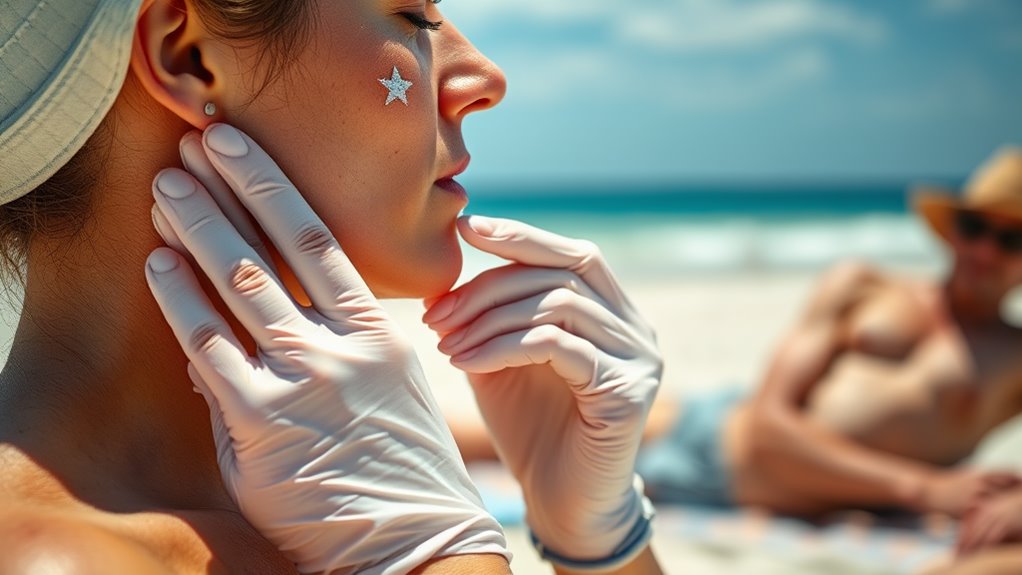The Best SPF Tips That Most People Ignore (Don’t Be One of Them)
Don’t ignore these game-changing SPF tips that could save your skin. Always opt for broad-spectrum SPF 30+ and apply it daily, even on overcast or indoor days, since UV rays sneak through clouds and windows. Reapply every two hours—especially after water or sweat—to slash sunburn risk by up to 90%. Cover overlooked spots like ears, lips, and hands, and pair it with UPF clothing for extra defense. Keep exploring for more essential strategies to lock in your protection.
Key Takeaways
- Apply broad-spectrum SPF 30+ daily, even on cloudy days or indoors, as UV rays penetrate clouds and windows.
- Reapply sunscreen every two hours outdoors, not just once, to prevent UV damage from sweat or fading protection.
- Use a full teaspoon of sunscreen for each body part, like face or arms, to ensure even and adequate coverage.
- Check sunscreen expiration dates and store in a cool, dark place to maintain its protective potency.
- Pair SPF with UPF 50+ clothing and stay hydrated to enhance overall skin defense against UV rays.
Why Broad-Spectrum SPF Matters Most
When you step into the sun, broad-spectrum SPF becomes your first line of defense against both UVA rays, which penetrate deeply and accelerate aging, and UVB rays, which cause burns and increase cancer risk.
In your sun care guide, broad-spectrum protection is essential because it shields against the full spectrum of UV damage, backed by studies showing it reduces skin cancer rates by up to 50%.
You prioritize it to maintain youthful skin and lower long-term health risks, making it the cornerstone of effective sun protection strategies.
Don’t overlook this vital step for overall skin health.
Addressing common myths about sunscreen can help ensure you’re maximizing its benefits based on scientific evidence.
This protection aligns with the idea that sunscreen is the most essential and cost-effective anti-aging product you can use.
The Right Way to Apply Sunscreen Daily
Applying sunscreen daily isn’t just about slathering it on; you must do it right to maximize protection against UVA and UVB rays. Choose a broad-spectrum SPF 30+ and apply it 15 minutes before sun exposure for optimal absorption, as dermatological studies confirm this enhances efficacy. Use generous amounts on all exposed skin, including often-forgotten areas like ears and feet, to prevent burns and long-term damage. For better decision-making, consider the protection levels of SPF 30 versus SPF 50 based on scientific comparisons.
It’s crucial to debunk sunscreen myths for better skin health.
Here’s a practical guide to get it right:
| Body Area | Recommended Amount | Application Technique |
|---|---|---|
| Face | 1 teaspoon | Gentle circular motions |
| Neck | 0.5 teaspoon | Upward strokes for even spread |
| Arms | 1 teaspoon per arm | Thorough rubbing |
| Legs | 2 teaspoons per leg | Smooth from bottom up |
| Back | 2 teaspoons | Use help for full coverage |
Ensure even application for daily defense.
Reapplying SPF After Water or Sweat
To keep your skin shielded from UV damage, reapply your sunscreen immediately after water exposure or heavy sweating, as these can strip away its protective barrier.
Research from the FDA confirms that even water-resistant products lose efficacy after 40-80 minutes in water or sweat. You must apply a generous amount—about one teaspoon per body part—to maintain full coverage.
Opt for sweat-proof formulas for activities like exercise or swimming, and always check the label for reapplication guidelines.
This simple habit slashes your sunburn risk by up to 90%, per dermatological studies, keeping your skin safe and healthy.
SPF for Overcast or Indoor Days
Even though overcast skies or indoor settings might seem harmless, UV rays can still penetrate clouds and windows, potentially damaging your skin.
Research from the Skin Cancer Foundation confirms that up to 80% of UVB rays reach you on cloudy days, while UVA rays slip through glass, increasing aging and cancer risks.
You must apply a broad-spectrum SPF 30+ daily, even indoors.
Don’t rely on assumptions—make it routine to protect against invisible threats.
Opt for water-resistant formulas if you’re near windows, ensuring year-round defense without excuses.
Stay proactive to safeguard your health.
Protecting Overlooked Areas Like Lips and Ears
While daily SPF application covers much of your skin, you shouldn’t neglect vulnerable spots like your lips and ears, which face high UV exposure and often lead to skin cancer.
Studies show lips are 10 times more likely to develop cancer due to their thin skin, so choose a lip balm with at least SPF 30 and reapply every two hours, especially after eating.
For ears, apply a broad-spectrum sunscreen generously, as they receive direct sunlight and account for up to 10% of skin cancers.
Make it routine: Use your fingertips for even coverage and pair with hats for extra protection.
Don’t skip these steps—they’re simple yet lifesaving.
Choosing the Ideal SPF Based on Your Skin
Selecting the right SPF for your skin depends on factors like your skin type, sun exposure level, and location. If you’re fair-skinned, choose SPF 50+ to minimize UV damage, as studies from the American Academy of Dermatology confirm. For medium skin, SPF 30-50 offers solid protection, while darker skin can use SPF 15-30 but shouldn’t skip it entirely.
To help you decide, here’s a practical guide:
| Skin Type | Recommended SPF | Key Considerations |
|---|---|---|
| Fair | 50+ | High UV sensitivity; reapply often |
| Medium | 30-50 | Balances daily wear and protection |
| Dark | 15-30 | Still essential for long-term health |
Tailor your choice based on evidence to keep your skin safe and healthy. To enhance your skin’s overall health, consider incorporating hydration techniques for lasting protection against dryness and damage.
Common SPF Mistakes to Avoid
You’ve likely made common SPF mistakes that compromise your skin’s protection, so let’s address them head-on.
You shouldn’t skip reapplication, as it wears off with sweat, water, or time, leaving you exposed to UV damage.
Plus, you must avoid using an expired product, since its active ingredients break down and lose effectiveness over time.
Skipping Reapplication
One common mistake with SPF is skipping reapplication, which leaves your skin exposed to harmful UV rays as the protection wears off. Research from the American Academy of Dermatology confirms that sunscreen breaks down after two hours due to sweat, water, or rubbing. You must reapply every two hours for optimal defense, reducing sunburn risk by up to 50%. Make it routine during activities.
| Scenario | Consequence |
|---|---|
| Reapply every 2 hours | Maintains strong UV barrier |
| Skip after sweating | Protection fades quickly |
| Forget during beach time | Skin burns and ages faster |
| Reapply post-swim | Restores full defense |
This simple habit safeguards your health long-term.
Using Expired Product
While expired sunscreen might seem harmless, using it significantly weakens its UV protection, leaving your skin vulnerable to damage.
The active ingredients break down over time, as confirmed by studies from the FDA, reducing SPF effectiveness by up to 90%. You risk sunburn, premature aging, and even skin cancer by ignoring expiration dates.
Always check the bottle’s label for the PAO symbol or printed date, and discard products over three years old or exposed to heat.
Store your sunscreen in a cool, dark place to preserve its potency.
Don’t compromise your skin’s defense—opt for fresh applications daily.
Integrating SPF Into Your Routine Year-Round
You’ve got to make daily SPF habits a cornerstone of your routine, applying it every morning regardless of the weather to shield your skin from UV damage.
In varying seasons, tweak your approach by opting for higher SPF in summer or lighter formulas in winter for ongoing protection.
Now, let’s examine these practical tips to ensure you’re covered all year.
Daily SPF Habits
Integrating SPF into your daily routine protects your skin from UV rays year-round, even on cloudy days.
UV radiation penetrates clouds, contributing to skin damage and cancer, as backed by dermatological studies.
Make SPF a seamless habit to maintain healthy skin.
To build effective daily habits, follow these practical steps:
- Apply a broad-spectrum SPF 30+ every morning after moisturizing.
- Reapply every two hours during outdoor activities.
- Use SPF in your daily moisturizer or foundation for convenience.
- Cover all exposed areas, including hands and lips.
- Pair it with sunglasses and hats for enhanced protection.
This approach ensures consistent defense against UV harm.
Seasonal Routine Tips
As seasons shift, you’ll need to adapt your SPF routine to counter varying UV intensities and environmental factors throughout the year.
Studies from the American Academy of Dermatology confirm UV exposure persists year-round, heightening skin cancer risks.
In summer, apply broad-spectrum SPF 50 daily and reapply every two hours during outdoor activities.
Winter requires at least SPF 30 to combat snow’s UV reflection, which can reach 80%.
For spring and fall, integrate SPF 30 into your daily moisturizer and layer up for windy conditions.
This practical strategy ensures consistent protection, preventing premature aging and damage.
Pairing SPF With Clothing and Accessories
While wearing sunscreen is essential, pairing it with UV-protective clothing and accessories amplifies your sun defense.
Research from the Skin Cancer Foundation confirms that UPF-rated fabrics block up to 98% of UV rays, offering a practical layer beyond lotions. You’ll enhance protection by integrating these into your routine, reducing burn risks and long-term damage. Additionally, to avoid common summer skincare mistakes like dehydration, make sure to stay hydrated throughout the day.
- Select UPF 50+ clothing: Blocks most UV rays for extended outdoor activities.
- Wear wide-brimmed hats****: Shields your face, neck, and ears effectively.
- Choose UV-blocking sunglasses: Protects your eyes and surrounding skin from cataracts.
- Opt for long sleeves and pants: Made from tightly woven fabrics to cover vulnerable areas.
- Use protective gloves: Ideal for hands during drives or gardening sessions.
To maintain overall skin health beyond sun protection, it’s crucial to moisturize regularly during colder months as part of essential skincare practices.





